MIDDLEFIELD, Conn., April 9, 2008 -- Zygo Corp.'s reputation for state-of-the-art interferometry is well known throughout the world. For almost four decades, however, the company has also been manufacturing high-precision optical components and systems serving applications ranging from laser eye surgery to aerial reconnaissance, becoming one of the largest and most advanced suppliers of laser fusion optics in the world.
Given the corporation's growth and strength in OEM optics, several internal business units were consolidated in 2007 to form what is now the Zygo Optical Systems Division. Comprised of two major groups, Optical Components and Electro-Optics, the division has facilities in Connecticut, Arizona, and California.
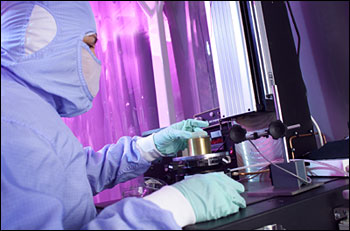
Zygo Optical Systems Div.'s facility in Tucson, which boasts Class 100 cleanroom capabilities, is ISO certified and FDA registered.
The 45,000-sq-ft facility in Tucson, Ariz., boasts Class 100 cleanroom capabilities, in-line production optical compensation, DFMA engineering services, is ISO 9001:2000 and 13485-2003 certified, and FDA registered, making it the ideal location for high-precision system manufacturing.
The Middlefield, Conn., facility contains proprietary rotary and spherical polishing equipment and processes capable of meeting λ/50 surface accuracy in production with surface roughness less than 0.2 nm rms.
The Costa Mesa, Calif., engineering and prototype facility is utilized throughout the industry for its ability to design, model, and build highly complex optical systems. As one can imagine, all three facilities enjoy close ties to Zygo’s Metrology Solutions Div. that provides proprietary production metrology solutions, further setting the Zygo Optical Systems Div. apart from traditional OEM manufacturers.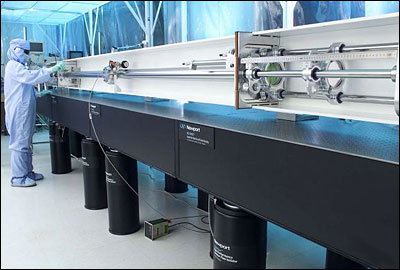
Vacuum relay telescopes built in volume at Zygo Optical Systems Div. in Tucson for the National Ignition Facility.
Combining the Tucson and Costa Mesa locations, the Electro-Optics Group focuses on complex electro-optical and optomechanical device development and volume production. Applications include medical laser delivery systems for surgical processes, cytology systems, medical and dental imaging systems, semiconductor objectives and optical systems, lithography optical systems, telescopes for military fire-control systems, VIS (visible) and IR (infrared) surveillance systems, advanced helmet-mounted displays, and more.
The organization supports new startup venture companies at early phase launch with concept design to breadboard prototypes for market assessments up to multibillion-dollar global companies that seek to rely on the Electro-Optics Group’s unique high precision, high quality manufacturing processes.
The engineering and prototyping team, located in Costa Mesa, is a team of engineers, scientists, and technicians with capabilities to manage all aspects of a customer’s product development cycle. A wide range of skills enables the group to engage customers at any level of their product development cycle, whether at the scope of work definition stage, or reviewing a design that’s already in production to reduce cost, increase performance, or improve quality.
The team utilizes the latest Code V and Zemax optical modeling software. A strategic alliance with Optical Research Associates is utilized for optical design efforts when appropriate. Mechanical design, solid modeling, finite element analysis, materials engineering, electrical engineering, and system engineering are also core competencies of the group.
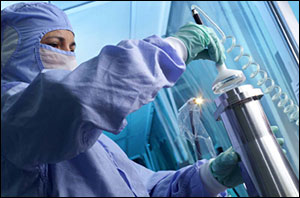
High-precision assembly of complex electro-optic devices.
The manufacturing center for the Electro-Optics Group is strategically located in Tucson’s optical resource rich environment. It is ideally situated near the University of Arizona’s Optical Science Center (U of A OSC). A number of optical designers and engineers in the group are U of A OSC alumni. The Tucson team works closely with the Costa Mesa and Middlefield teams to transition designs and prototypes into volume production. They also participate directly with customer teams on cost reduction, performance improvement, and quality improvement programs.
The facility in Tucson is ISO 9001:2000 and ISO 13485:2003 registered, ITAR registered, and routinely audited to FDA standards. Capabilities include design for manufacturing and assembly, value stream mapping, lean manufacturing principles, and Kan-Ban manufacturing systems. Beyond the ISO and ITAR registrations the site also conforms to several other guidelines, including Fed. Std. 209E cleanroom standards, ISO 14644 cleanroom standards, and Mil. Std. 1246C component cleanliness standard.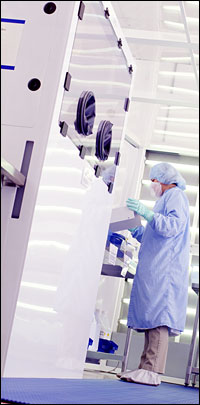
A cleanroom at Zygo Optical Systems Div.'s Tucson facility.
Together, the Costa Mesa and Tucson teams function as a well-rounded product incubation team that offers the following services to help compliment customers’ engineering teams or assume full responsibilities for electro-optic product development and launch:
Optical Engineering- Optical design
- Design optimization
- Performance analysis
- Stray light control
- Tolerance analysis
- Environmental survivability
- UV, VIS, IR
Mechanical Engineering- Structural analysis
- Thermal analysis
- 2-D/3-D CAD/CAM
- High density packaging
Materials & Process Engineering
- Coating development
- Material interactions
- Joining technologies
Manufacturing, Engineering & Support- High-precision manufacturing
- Producibility
- Integration and test
- Design for manufacturing and assembly
- Full documentation
- Kan-Ban
- Lean Principles
- Value-stream mapping
Quality & Regulatory Compliance- ISO 13485:2003 for medical devices
- ISO 9001:2000
- FDA-level quality audits
- ITAR registered
- World-class standards for cleaning and cleanliness
System Engineering- Requirements definition
- System modeling and performance prediction
- Configuration management
Program Management- Full program management from concept through production
- Product development process
How do you know if your project is right for Zygo’s Electro-Optics Group? Typical applications include systems with multiple beam paths, fast optics, and a combination of technologies like laser imaging systems, critical sensor alignment, and regulated or highly specified, auditable requirements such as medical devices (ISO/FDA), defense and aerospace (ITAR), and semiconductor (cleanliness).
Another clear sign of a good fit is when active-metrology-based alignment and compensation techniques are required to optimize performance. In this case, simply dry stacking and adhering optics won’t allow the design to achieve the desired performance results.
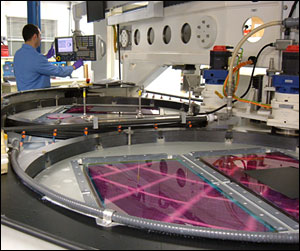
One of the multiple 168-in. rotary polishing machines Zygo Optical Systems Div. has at its facility in Middlefield, Conn.
The Optical Components group, located in Middlefield, Conn., differentiates itself by focusing on high-precision optical component fabrication where the integration of specialized metrology capabilities into customized fabrication equipment and processes provides a competitive advantage and high quality, high performance products for OEM customers.
Capabilities within the Optical Components group include one of the largest glass CNC (computer numerical control) facilities in North America for generating, light weighting, edging, and machining specialized glass structures; multiple rotary polishing machines capable of polishing parts to more than 1 m in diameter; double-sided grinding and polishing equipment and specialized processes for efficient and effective processing of special materials like sapphire; MRF (magnetorheological finishing) capabilities up to 1 m; thin-film coatings and specialized cleaning operations.
Products, applications, and services of the Optical Components group include:
- High performance windows for UV, VIS, and IR applications such as aerial surveillance
- Specialty meter class optics for telescope, airborne, and space applications
- High fluence optics including prisms, laser amplifier slabs, windows, mirrors, and debris shields used in applications such as laser fusion research and military fire control systems
- High-precision flats with tight wedge control
- High-precision prisms and beamsplitters
- Precision reference (straight and L) mirrors used for precision positioning systems
- Specialty lenses
- Mirrors from 4 in. to more than 40 in.
- Precision-machined structures and surfaces such as monolithic stages, wafer chucks, straight edges, and ring-laser gyro frames
- Edging, contouring, and shaping high-precision optical components
- Thin-film coatings including metal (silver, aluminum, gold) coatings, antireflective coatings for UV, VIS, and IR, beamsplitter coatings, dielectric coatings, and custom OEM coating development
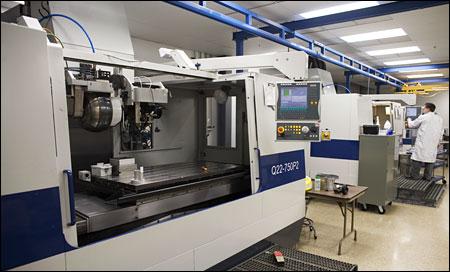 |
An MRF (magnetorheological finishing) machining center at Zygo Optical Systems Div.'s facility in Middlefield. Zygo's MRF department has capabilities to process parts over 1 m in length.
|
Capabilities within the Optical Components group include:
- CNC glass machining to >1-m diameter
- Glass machining to > 1-m diameter
- Light weighting
- Edging, contouring
- Rotary Polishing (up to 1.2-m diameter)
- Flats to 12 nm (λ/50) PV
- Low-power spectral density signatures
- Surface roughness to < 0.2-nm rms
- Angular tolerances to 0.1 arc second
- 20/10 at meter class optics
- Double-Sided (up to 0.5-m diameter)
- Flats to 63 nm (λ/10) PV
- Surface roughness to < 1-nm rms
- Wedge tolerances to 2 arc second
- 20/10 at meter class optics
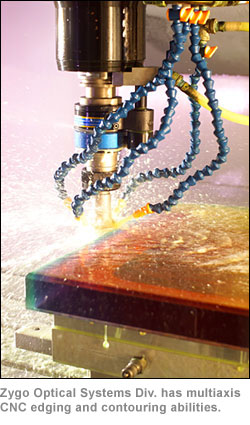
- MRF Polishing (up to 1-m diameter)
- Cleaning
- Class 10,000 and 100,000 cleanrooms
- Materials processed
- Precision optical glass, fused silica, sapphire, Cleartran, ZnS, Zerodur, Clearceram, ceramics, silicon, Alon, phosphate, and more
- Coating
- Sizes from 1 to 760 mm
- Wavelengths from 200 to 2000 nm
- High-efficiency antireflective coatings
- Polarizing and nonpolarizing beamsplitters and prisms
- Custom coating design and manufacturing
- Low-stress metal and dielectric coatings
- Aluminum, silver, and enhanced reflectors
- High laser damage threshold coatings
- Polarization beam combiners
Combining the capabilities and talents within the Optical Components Group and the Electro-Optics Group, Zygo Optical Systems Div. offers a unique OEM Product Introduction Lifecycle partnership to the customer. The broad product and skill sets encompassed within the division and the entire Zygo Corp. enables customers to work with one partner throughout the product introduction lifecycle, saving time and costs while ensuring design options are synchronized with process capabilities from the start.
Zygo Optical Systems Div. has a broad market reach and is supported by the highest performance metrology products and resources in the world, which is critical when designing and building high precision, complex optically based products.
For more information, visit: www.zygo.com/?/optics/